Preparation of Filter Paper from Bamboo and Investigating the Effect of Additives
Abstract
:1. Introduction
2. Materials and Methods
2.1. Preparation of Bamboo Chips and Fibers
2.2. Pulping Conditions
2.3. Bleaching
2.4. Oxidation Treatment
2.5. Additives
2.6. Filter Paper Making
2.7. Testing Methods
3. Results and Discussion
3.1. Chemical Composition and Fiber Dimensions
3.2. Pulp Yield and Kappa Number
3.3. Brightness
3.4. Tear Strength
3.5. Burst and Tensile Index
3.6. Air Permeability Measurement
3.7. Scanning Electron Microscopy (SEM)
3.8. Fourier Transform Infrared Spectroscopy (FTIR)
3.9. Nitrogen Adsorption Isotherms
4. Conclusions
Author Contributions
Funding
Institutional Review Board Statement
Informed Consent Statement
Data Availability Statement
Acknowledgments
Conflicts of Interest
References
- Jung, S.; Kim, J. Advanced design of fiber-based particulate filters: Materials, morphology, and construction of fibrous assembly. Polymers 2020, 12, 1714. [Google Scholar] [CrossRef]
- Suriaman, I.; Hendrarsakti, J.; Mardiyati, Y.; Pasek, A.D. Synthesis and characterization of air filter media made from cellulosic ramie fiber (Boehmeria nivea). Carbohydr. Polym. Technol. Appl. 2022, 3, 100216. [Google Scholar] [CrossRef]
- Macfarlane, A.L.; Kadla, J.F.; Kerekes, R.J. High performance air filters produced from freeze-dried fibrillated wood pulp: Fiber network compression due to the freezing process. Ind. Eng. Chem. Res. 2012, 51, 10702–10711. [Google Scholar] [CrossRef]
- Tripathi, S.K.; Mishra, O.P.; Bhardwaj, N.K.; Varadhan, R. Pulp and papermaking properties of bamboo species Melocanna baccifera. Cellul. Chem. Technol. 2018, 52, 81–88. [Google Scholar]
- Abd El-Sayed, E.S.; El-Sakhawy, M.; El-Sakhawy, M.A.M. Non-wood fibers as raw material for pulp and paper industry. Nord. Pulp Pap. Res. J. 2020, 35, 215–230. [Google Scholar] [CrossRef]
- Ilyas, R.A.; Harussani, M.M.; Ibrahim, R.; Ainun, Z.M.A. Pulp and papermaking from sustainable lignocellulosic bamboo. In Proceedings of the 8th Postgraduate Seminar on Natural Fibre Composites & Undergraduate Seminar on Fabrication and Characterization of the Composite Materials (FCCM2022), UPM, Serdang, Malaysia, 30 January 2022. [Google Scholar]
- Chen, Z.; Zhang, H.; He, Z.; Zhang, L.; Yue, X. Bamboo as an emerging resource for worldwide pulping and papermaking. BioResources 2019, 14, 3–5. [Google Scholar] [CrossRef]
- Sugesty, S.; Kardiansyah, T.; Hardiani, H. Bamboo as raw materials for dissolving pulp with environmental friendly technology for rayon fiber. Procedia Chem. 2015, 17, 194–199. [Google Scholar] [CrossRef]
- Chen, C.; Chen, G.; Sun, G.; Wang, J.; Wang, G. Windmill palm fiber/polyvinyl alcohol nonwoven fibrous polymeric materials. J. Eng. Fibers Fabr. 2016, 11, 155892501601100402. [Google Scholar] [CrossRef]
- Lee, S.K.; Park, E.Y.; Park, T.S.; An, S.K. Mechanical properties of PP/glass fiber/kenaf/bamboo fiber-reinforced hybrid composite. Fibers Polym. 2021, 22, 1460–1465. [Google Scholar] [CrossRef]
- Janko, M.; Jocher, M.; Boehm, A.; Babel, L.; Bump, S.; Biesalski, M.; Meckel, T.; Stark, R.W. Cross-linking cellulosic fibers with photoreactive polymers: Visualization with confocal Raman and fluorescence microscopy. Biomacromolecules 2015, 16, 2179–2187. [Google Scholar] [CrossRef]
- Peterus, J.U. Evaluation of Bamboo Paper Properties by Blending Recycled Pulp and Starch. Prog. Eng. Appl. Technol. 2023, 4, 702–713. [Google Scholar]
- Tutus, A.; Cicekler, M.; Kucukbey, N. Pulp and paper production from bitter orange (Citrus aurantium L.) woods with Soda-AQ method. Kastamonu Üniversitesi Orman Fakültesi Derg. 2016, 16, 14–18. [Google Scholar] [CrossRef]
- Masrol, S.R.; Ibrahim, M.H.I.; Adnan, S.; Abdul Raub, R.; Sa’adon, A.M.; Sukarno, K.I.; Yusoff, M.F.H. Durian rind soda-anthraquinone pulp and paper: Effects of elemental chlorine-free bleaching and beating. J. Trop. For. Sci. 2018, 30, 106–116. [Google Scholar] [CrossRef]
- Zhang, D.C.; Pu, Y.; Courchene, C.E.; Chai, X.S.; Ragauskas, A.J. Total fibre charge of fully bleached SW kraft pulps: A comparative study. J. Pulp Pap. Sci. 2006, 32, 231–237. [Google Scholar] [CrossRef]
- Li, L.; Lee, S.; Lee, H.; Youn, H. Hydrogen peroxide bleaching of hardwood kraft pulp with adsorbed birch xylan and its effect on paper properties. BioResources 2011, 6, 721–736. [Google Scholar] [CrossRef]
- TAPPI T 402 sp-08; Standard Conditioning and Testing Atmospheres for Paper, Board, Pulp Handsheets, and Related Products. Technical Association of the Pulp and Paper Industry. Tappi Tappi Press Atlanta: Atlanta, GA, USA, 2013.
- TAPPI T203 cm-09; Alpha-, Beta- and Gamma-Cellulose in Pulp. Technical Association of the Pulp and Paper Industry: Atlanta, GA, USA, 2009.
- TAPPI T222 om-11; Acid Insoluble Lignin in Wood and Pulp. Technical Association of the Pulp and Paper Industry: Atlanta, GA, USA, 2011.
- TAPPI T267 om-85; Technical Association of the Pulp and Paper Industry: Atlanta, GA, USA, 1985.
- TAPPI T 210 cm-93; Grammage of Paper and Paperboard (Weight Per Unit Area). Technical Association of the Pulp and Paper Industry: Atlanta, GA, USA, 1993.
- TAPPI T236 om-06; Kappa Number of Pulp. Technical Association of the Pulp and Paper Industry—Tappi Test Methods; Tappi Press: Atlanta, GA, USA, 2011.
- TAPPI T 494 om-06; Tensile Properties of Paper and Paperboard (Using Constant Rate of Elongation Apparatus). Technical Association of the Pulp and Paper Industry: Atlanta, GA, USA, 2013.
- TAPPI T T403 om-10; Bursting Strength of Paper. Technical Association of the Pulp and Paper Industry: Atlanta, GA, USA, 2010.
- TAPPI T 414 om-21; Internal Tearing Resistance of Paper (Elmendorf-Type Method). Technical Association of Pulp and Paper Industry: Atlanta, GA, USA, 2021.
- TAPPI T 272 sp-08; Forming Handsheets for Reflectance Testing of Pulp (Sheet Machine Procedure). Technical Association of Pulp and Paper Industry: Atlanta, GA, USA, 2008.
- ISO 5636-3:2013(E); Paper and Board—Determination of Air Permeance (Medium Range)—Part 3: Bendtsen Method. International Organization for Standardization: Geneva, Switzerland, 2013.
- Khantayanuwong, S.; Yimlamai, P.; Chitbanyong, K.; Wanitpinyo, K.; Pisutpiched, S.; Sungkaew, S.; Sukyai, P.; Puangsin, B. Fiber morphology, chemical composition, and properties of kraft pulping handsheet made from four Thailand bamboo species. J. Nat. Fibers 2023, 20, 2150924. [Google Scholar] [CrossRef]
- Ventorim, G.; Favaro, J.S.C.; Frigieri, T.C. Effect of kraft pulping temperature and alkalinity on eucalyptus ecf bleaching. Cellul. Chem. Technol. 2016, 50, 1025–1033. [Google Scholar]
- Jahan, M.S.; Sarkar, M.; Rahman, M.M. Sodium carbonate pre-extraction of bamboo prior to soda-anthraquinone pulping. Biomass Convers. Biorefinery 2015, 5, 417–423. [Google Scholar] [CrossRef]
- Resalati, H.; Kajforush, S.; Ghasemian, A.; Saraeyan, A. The effect of chlorine dioxide charges in chlorine dioxide-alkaline extraction-chlorine dioxide (DED) sequence on optical properties of kraft pulp of Eucalyptus camaldulensis. J. Environ. Sci. Eng. 2012, 1, 181–186. [Google Scholar]
- Tajik, M.; Torshizi, H.J.; Resalati, H.; Hamzeh, Y. Effects of cationic starch in the presence of cellulose nanofibrils on structural, optical and strength properties of paper from soda bagasse pulp. Carbohydr. Polym. 2018, 194, 1–8. [Google Scholar] [CrossRef]
- Ramaraj, B. Crosslinked poly (vinyl alcohol) and starch composite films. II. Physicomechanical, thermal properties and swelling studies. J. Appl. Polym. Sci. 2007, 103, 909–916. [Google Scholar] [CrossRef]
- Khanjani, P.; Kosonen, H.; Ristolainen, M.; Virtanen, P.; Vuorinen, T. Interaction of divalent cations with carboxylate group in TEMPO-oxidized microfibrillated cellulose systems. Cellulose 2019, 26, 4841–4851. [Google Scholar] [CrossRef]
- Begum, M.H.A.; Hossain, M.M.; Gafur, M.A.; Kabir, A.H.; Tanvir, N.I.; Molla, M.R. Preparation and characterization of polyvinyl alcohol–starch composites reinforced with pulp. SN Appl. Sci. 2019, 1, 1091. [Google Scholar] [CrossRef]
- Su, W.; Hui, L.; Ma, X.; Wang, L.; Wang, Y. Preparation of High-precision Electrospun Nanoair Filter Paper for Air Purification. Pap. Biomater. 2021, 6, 12–20. [Google Scholar]
- Kan, Y.; Bondareva, J.V.; Statnik, E.S.; Cvjetinovic, J.; Lipovskikh, S.; Abdurashitov, A.S.; Kirsanova, M.A.; Sukhorukhov, G.B.; Evlashin, S.A.; Salimon, A.I.; et al. Effect of Graphene Oxide and Nanosilica Modifications on Electrospun Core-Shell PVA–PEG–SiO2@ PVA–GO Fiber Mats. Nanomaterials 2022, 12, 998. [Google Scholar] [CrossRef]
- Strand, A.; Sundberg, A.; Retulainen, E.; Salminen, K.; Oksanen, A.; Kouko, J.; Ketola, A.; Khakalo, A.; Rojas, O. The effect of chemical additives on the strength, stiffness and elongation potential of paper. Nord. Pulp. Pap. Res. J. 2017, 32, 324–335. [Google Scholar] [CrossRef]
- Rice, M.C.; Pal, L.; Gonzalez, R.; Hubbe, M.A. Wet-end addition of nanofibrillated cellulose pretreated with cationic starch to achieve paper strength with less refining and higher bulk. Tappi J. 2018, 17, 395–403. [Google Scholar] [CrossRef]
- Xu, Z.; Li, J.; Zhou, H.; Jiang, X.; Yang, C.; Wang, F.; Pan, Y.; Li, N.; Li, X.; Shi, L.; et al. Morphological and swelling behavior of cellulose nanofiber (CNF)/poly (vinyl alcohol)(PVA) hydrogels: Poly (ethylene glycol)(PEG) as porogen. RSC Adv. 2016, 6, 43626–43633. [Google Scholar] [CrossRef]
- Ebrahimi, I.; Gashti, M.P.; Sarafpour, M. Photocatalytic discoloration of denim using advanced oxidation process with H2O2/UV. J. Photochem. Photobiol. A Chem. 2018, 360, 278–288. [Google Scholar] [CrossRef]
- Zhang, Y.; Deng, W.; Liu, C.; Yan, F.; Wu, M.; Cui, Q.; Willfor, S.; Xu, C.; Li, B. Preparation of Antibacterial Dialdehyde Nanocellulose Using Libr·3h2o Non-Dissolving Pretreatment Promoted Periodate Oxidation. ACS Sustain. Chem. Eng. 2023, 11, 6641–6651. [Google Scholar] [CrossRef]
- Tang, Z.; Li, W.; Lin, X.; Xiao, H.; Miao, Q.; Huang, L.; Chen, L.; Wu, H. TEMPO-oxidized cellulose with high degree of oxidation. Polymers 2017, 9, 421. [Google Scholar] [CrossRef] [PubMed]
- Yao, Y.; Wang, C.; Wang, X.; Yang, Y.; Wan, Y.; Chen, J.; Ding, F.; Tang, Y.; Wang, Z.; Liu, L.; et al. Activation of fulvic acid-like in paper mill effluents using H2O2/TiO2 catalytic oxidation: Characterization and salt stress bioassays. J. Hazard. Mater. 2019, 378, 120702. [Google Scholar] [CrossRef] [PubMed]
- Ji, Y.; Liang, N.; Xu, J.; Zuo, D.; Chen, D.; Zhang, H. Cellulose and poly (vinyl alcohol) composite gels as separators for quasi-solid-state electric double layer capacitors. Cellulose 2019, 26, 1055–1065. [Google Scholar] [CrossRef]
- Ertek, D.A.; Yüksek, M. Polyvinyl alcohol (pva)/cellulose acetate (ca) based environmentally friendly hybrid filter production. In Proceedings of the 8th International Textiles Congress, Izmir, Turkiye, 13–14 October 2022. [Google Scholar]
- Ferreira, P.J.; Gamelas, J.A.; Moutinho, I.M.; Ferreira, A.G.; Gómez, N.; Molleda, C.; Figueiredo, M.M. Application of FT-IR-ATR spectroscopy to evaluate the penetration of surface sizing agents into the paper structure. Ind. Eng. Chem. Res. 2009, 48, 3867–3872. [Google Scholar] [CrossRef]
- Shrotri, A.; Kobayashi, H.; Fukuoka, A. Air oxidation of activated carbon to synthesize a biomimetic catalyst for hydrolysis of cellulose. ChemSusChem 2016, 9, 1299–1303. [Google Scholar] [CrossRef]
- Azhar, O.; Jahan, Z.; Sher, F.; Niazi, M.B.K.; Kakar, S.J.; Shahid, M. Cellulose acetate-polyvinyl alcohol blend hemodialysis membranes integrated with dialysis performance and high biocompatibility. Mater. Sci. Eng. C 2021, 126, 112127. [Google Scholar] [CrossRef]

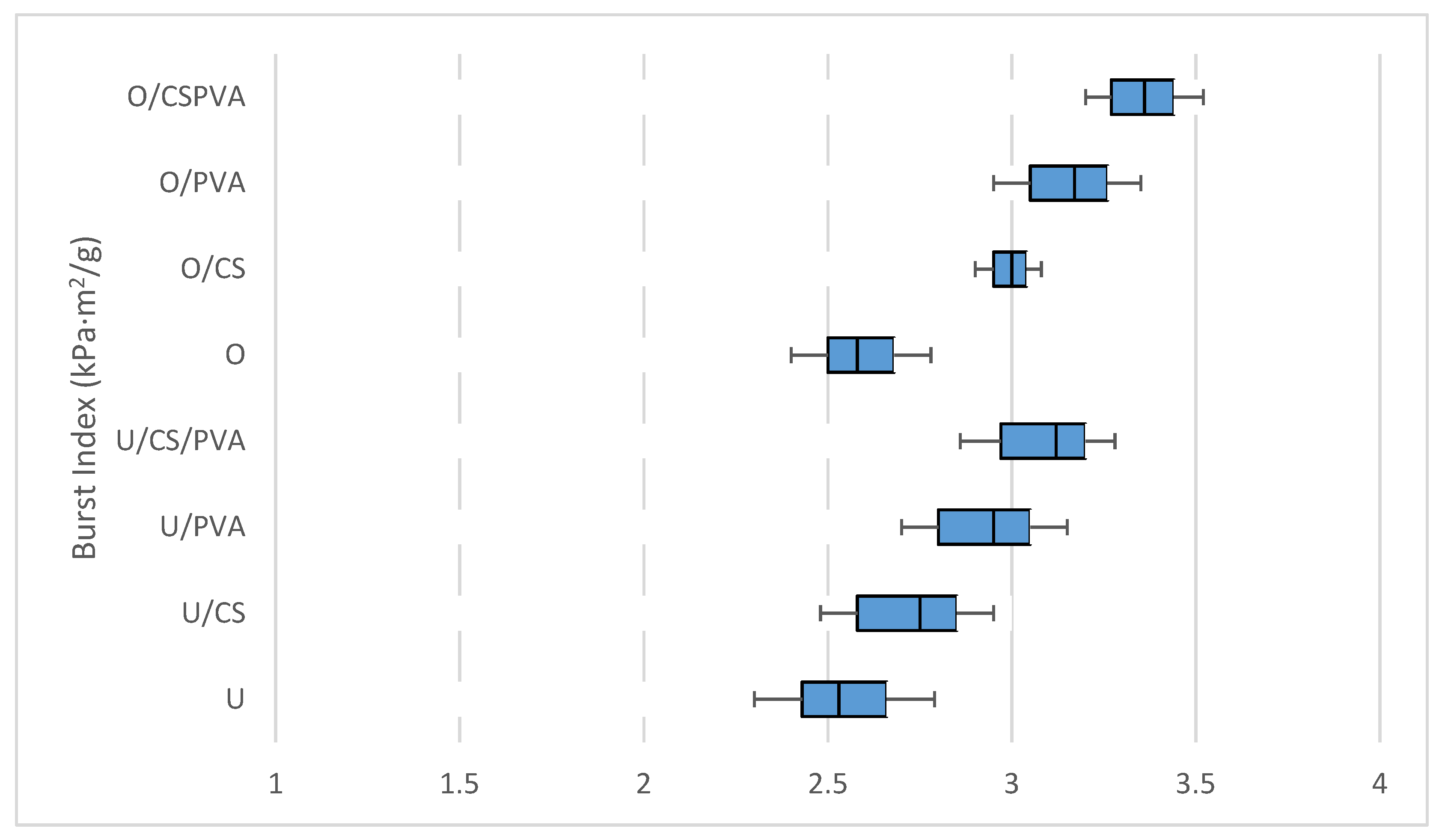

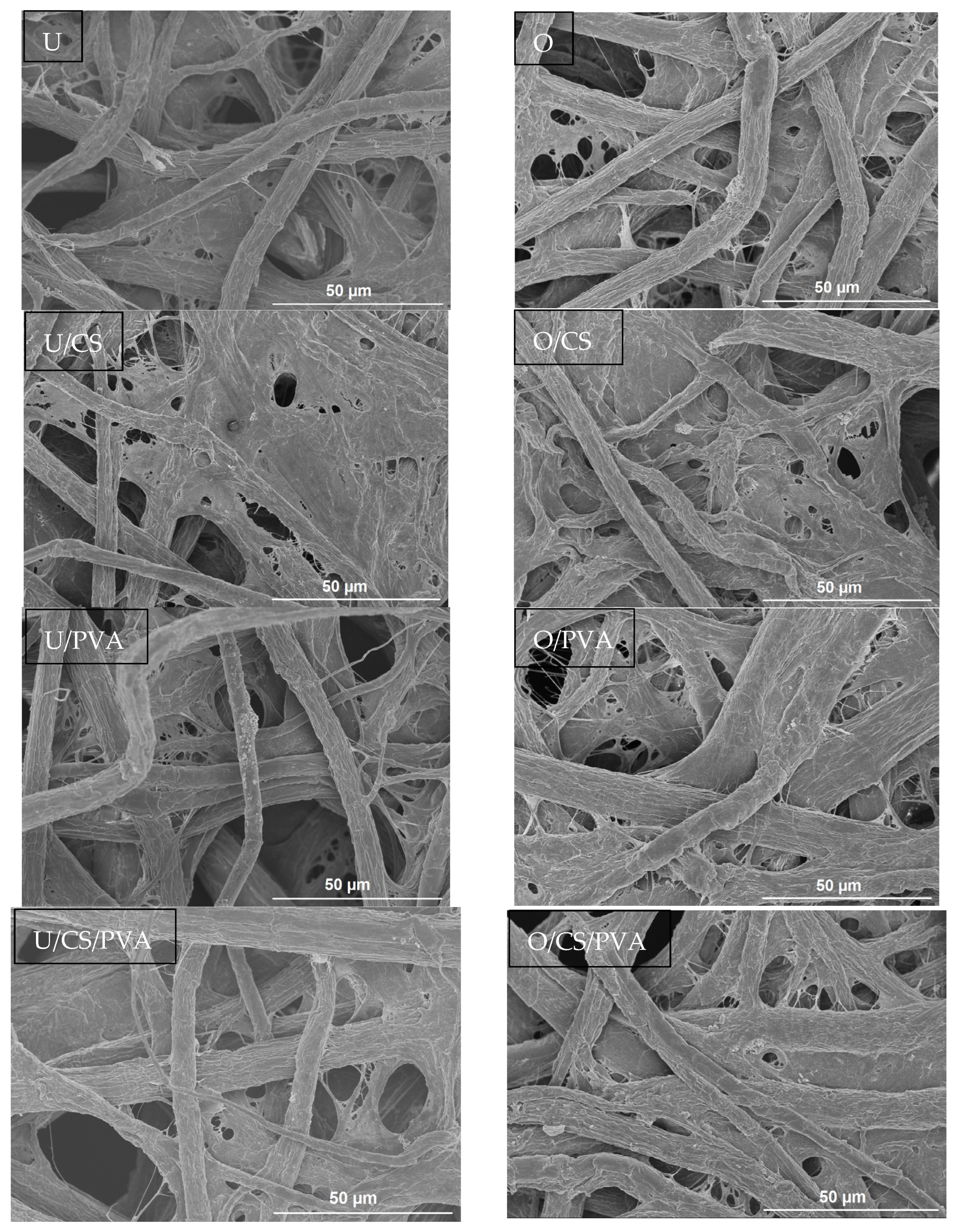
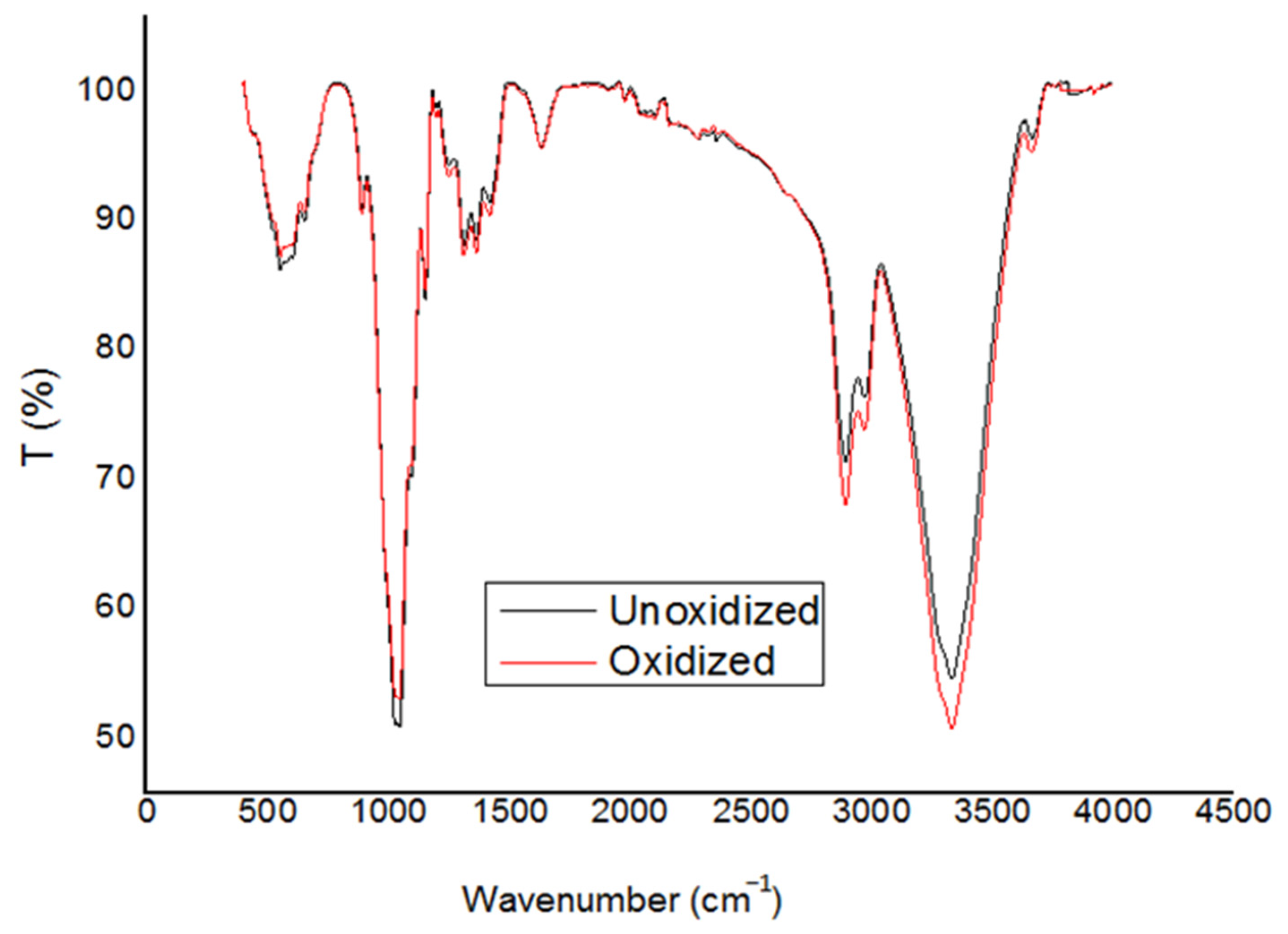
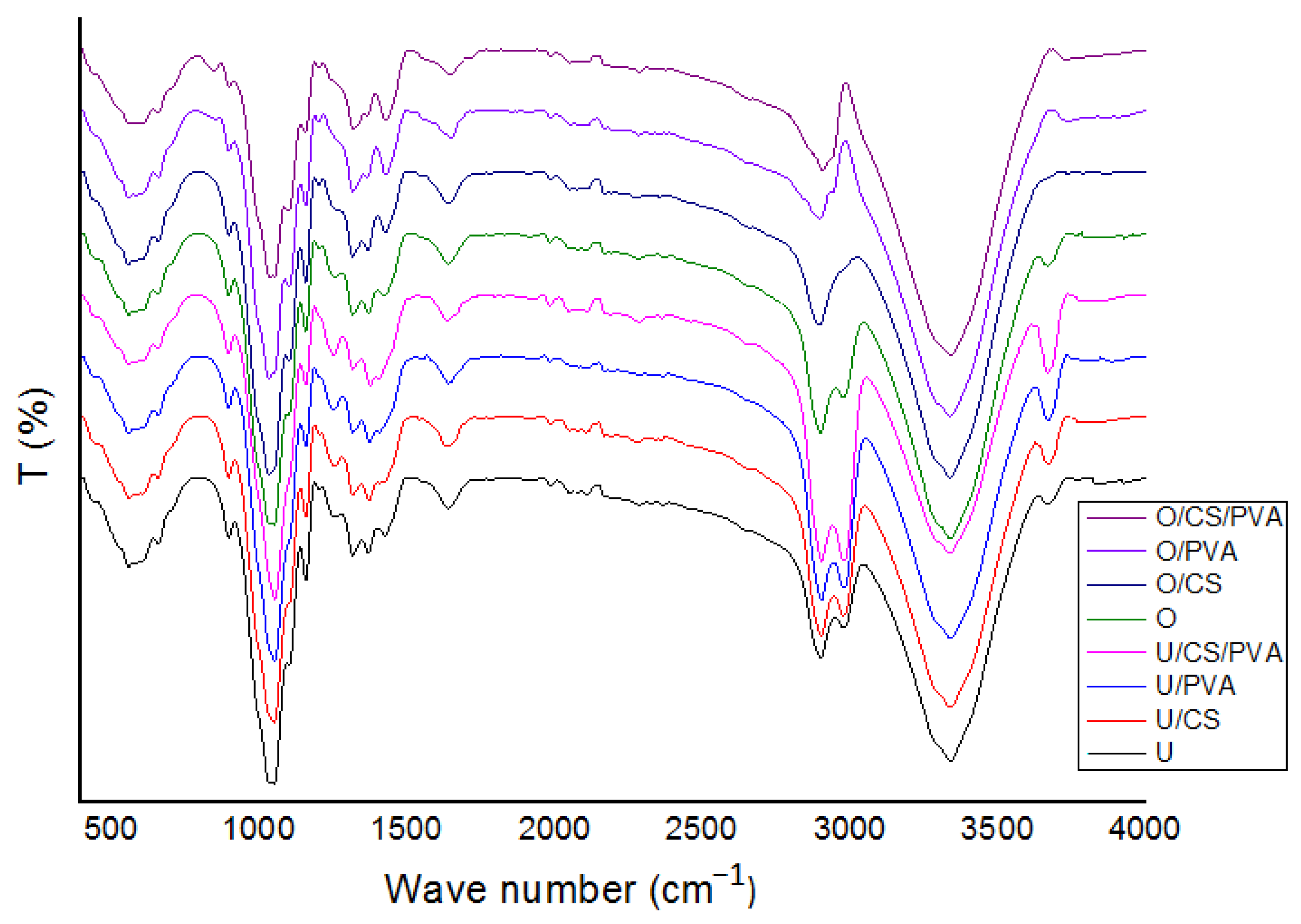
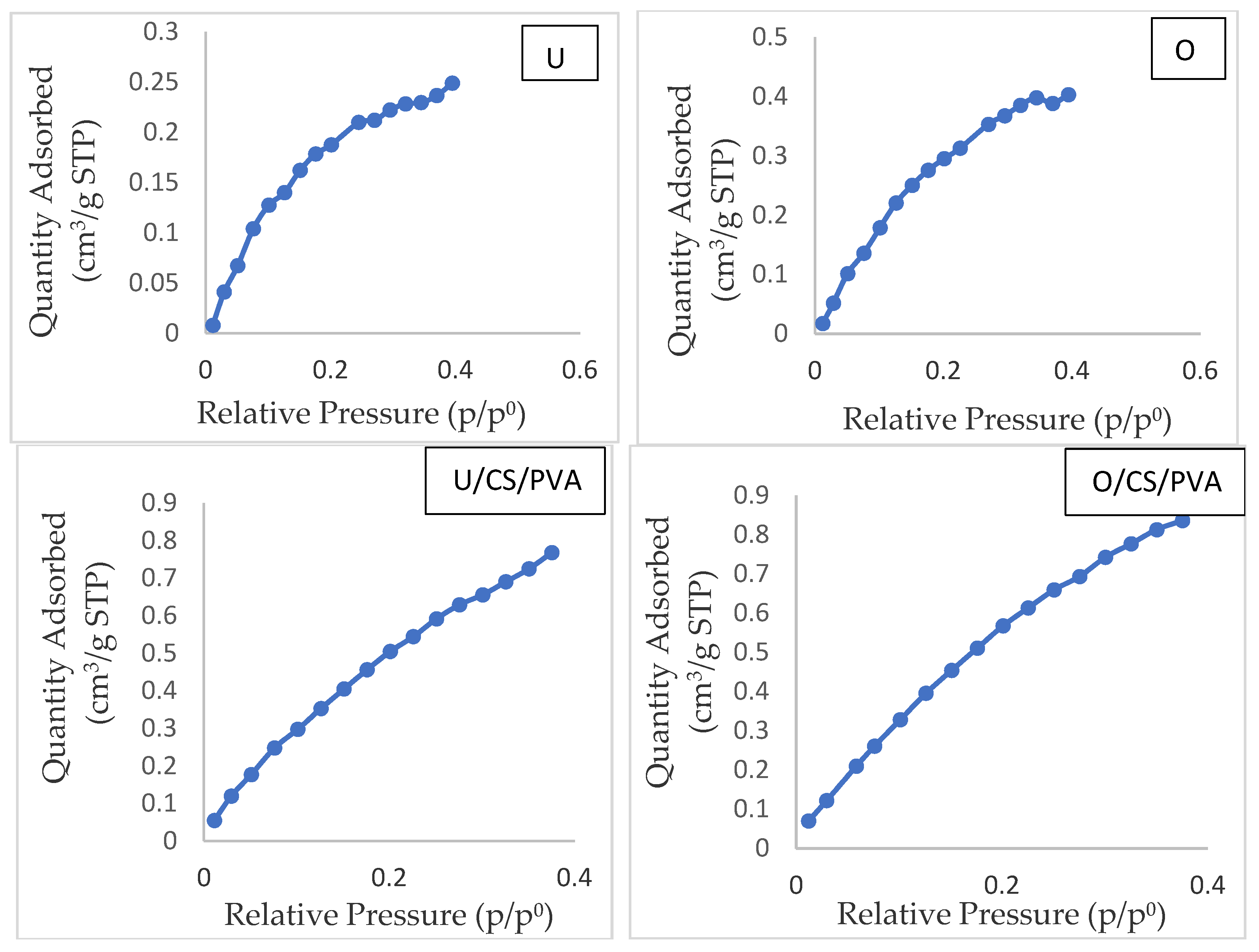
| Samples | Additives | Treatment |
|---|---|---|
| U | - | |
| U/CS | Cationic starch | |
| U/PVA | PVA | Unoxidized |
| U/CS/PVA | Cationic starch + PVA | |
| O | - | |
| O/CS | Cationic starch | Oxidized |
| O/PVA | PVA | |
| O/CS/PVA | Cationic starch + PVA |
| Temperature (°C) | AQ (% Dry Weight) | Total Yield (%) | Kappa Number | Lignin (%) |
|---|---|---|---|---|
| 185 | 0 | 28 | 26.10 | 4.3 |
| 185 | 0.1 | 31 | 24.66 | 4 |
| 185 | 0.2 | 35 | 20.54 | 3.38 |
| 175 | 0 | 35 | 46.46 | 7.6 |
| 175 | 0.1 | 38 | 36.45 | 6 |
| 175 | 0.2 | 42 | 17.5 | 2.8 |
| Filter Papers | Air Permeability (μm/Pa·s) | Filter Papers | Air Permeability (μm/Pa·s) |
|---|---|---|---|
| U | 78.4 ± 1.07 * | O | 79.1 ± 0.42 |
| U/CS | 77.3 ± 1.25 | O/CS | 78.4 ± 1.00 |
| U/PVA | 80.2 ± 1.52 | O/PVA | 79.4 ± 1.49 |
| U/CS/PVA | 81.35 ± 0.77 | O/CS/PVA | 83.8 ± 0.65 |
| Filter Papers | Average Pore Size (µm) | Porosity (%) | Filter Papers | Average Pore Size (µm) | Porosity (%) |
|---|---|---|---|---|---|
| U | 4.51 | 2.07 | O | 3.75 | 2.17 |
| U/CS | 1.44 | 0.66 | O/CS | 1.48 | 1.11 |
| U/PVA | 3.56 | 3.39 | O/PVA | 3.11 | 2.81 |
| U/CS/PVA | 3.90 | 4.06 | O/CS/PVA | 3.62 | 4.64 |
Disclaimer/Publisher’s Note: The statements, opinions and data contained in all publications are solely those of the individual author(s) and contributor(s) and not of MDPI and/or the editor(s). MDPI and/or the editor(s) disclaim responsibility for any injury to people or property resulting from any ideas, methods, instructions or products referred to in the content. |
© 2024 by the authors. Licensee MDPI, Basel, Switzerland. This article is an open access article distributed under the terms and conditions of the Creative Commons Attribution (CC BY) license (https://creativecommons.org/licenses/by/4.0/).
Share and Cite
Karchangi, Z.K.; Nazarnezhad, N.; Labidi, J.; Sharifi, S.H. Preparation of Filter Paper from Bamboo and Investigating the Effect of Additives. Materials 2024, 17, 1977. https://doi.org/10.3390/ma17091977
Karchangi ZK, Nazarnezhad N, Labidi J, Sharifi SH. Preparation of Filter Paper from Bamboo and Investigating the Effect of Additives. Materials. 2024; 17(9):1977. https://doi.org/10.3390/ma17091977
Chicago/Turabian StyleKarchangi, Zahra Kazemi, Noureddin Nazarnezhad, Jalel Labidi, and Seyed Hassan Sharifi. 2024. "Preparation of Filter Paper from Bamboo and Investigating the Effect of Additives" Materials 17, no. 9: 1977. https://doi.org/10.3390/ma17091977







